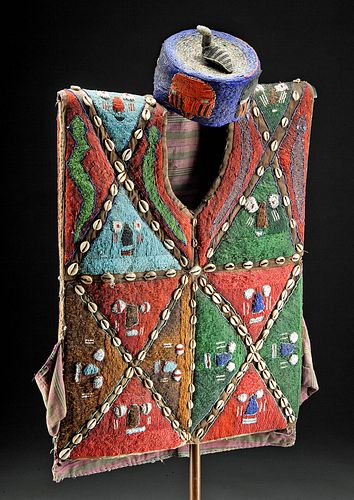20th C. African Yoruba Beaded & Shell Hat & Tunic
Lot 224
About Seller
Artemis Gallery
686 S Taylor Ave, Ste 106
Louisville, CO 80027
United States
Selling antiquities, ancient and ethnographic art online since 1993, Artemis Gallery specializes in Classical Antiquities (Egyptian, Greek, Roman, Near Eastern), Asian, Pre-Columbian, African / Tribal / Oceanographic art. Our extensive inventory includes pottery, stone, metal, wood, glass and textil...Read more
Categories
Estimate:
$1,800 - $2,500
Absentee vs Live bid
Two ways to bid:
- Leave a max absentee bid and the platform will bid on your behalf up to your maximum bid during the live auction.
- Bid live during the auction and your bids will be submitted real-time to the auctioneer.
Bid Increments
| Price | Bid Increment |
|---|---|
| $0 | $25 |
| $300 | $50 |
| $1,000 | $100 |
| $2,000 | $250 |
| $5,000 | $500 |
| $10,000 | $1,000 |
| $20,000 | $2,500 |
| $50,000 | $5,000 |
| $100,000 | $10,000 |
| $200,000 | $20,000 |
About Auction
By Artemis Gallery
Jun 10, 2021
Set Reminder
2021-06-10 10:00:00
2021-06-10 10:00:00
America/New_York
Bidsquare
Bidsquare : Exceptional Antiquities | Asian | Ethnographic
https://www.bidsquare.com/auctions/artemis-gallery/exceptional-antiquities-asian-ethnographic-7012
Museum-worthy examples of Egyptian, Greek, Roman, Viking, Near Eastern, Far East / Asian, Pre-Columbian, African / Tribal, Oceanic, Native American, Spanish Colonial, Russian, Fossils, Ancient Jewelry, Fine Art, so much more! Artemis Gallery info@artemisgallery.com
Museum-worthy examples of Egyptian, Greek, Roman, Viking, Near Eastern, Far East / Asian, Pre-Columbian, African / Tribal, Oceanic, Native American, Spanish Colonial, Russian, Fossils, Ancient Jewelry, Fine Art, so much more! Artemis Gallery info@artemisgallery.com
- Lot Description
West Africa, Nigeria, Yoruba Culture, ca. early to mid-20th century. A spectacular tunic and hat made from cotton cloth and covered with thousands of glass seed beads and shells to form colorful patterns and symbols. The hat is a skull cap design with a rounded, squat profile, and surmounting the top is a beaded cloth bird finial. The surface of the hat is also covered with a ground of beadwork in cobalt blue with stylized faces in black, red, and white. The tunic is constructed from several panels of cloth, necessary to support the superb beadwork, which adds substantial weight to this piece. The frontside is made up of triangular sections that contain abstract anthropomorphic faces that consist of a linear mouth, protruding human eyes and nose with ritualistic tattoos or scars flanking the nose, all on a solid beaded ground. The faces are bordered by strips of cloth that contain only cowrie shells. Abstract snakes in green and brown beads are depicted along the shoulders. Simple pockets are sewn into the sides to connect the front and back tunic panels. In addition to the faces and snakes, fish and Guinea fowl birds decorate the verso of the tunic, and smaller patterns of triangular beadwork outline the motifs. This tunic and cap were intended for a man of prestige such as a king or priest to wear. This beadwork must have taken hundreds of painstaking hours to complete, and the result is simply gorgeous. Size of hat: 7.5" W x 5.5" H (19 cm x 14 cm) tunic: 30" L x 21.5" W (76.2 cm x 54.6 cm) Size: 56" H (142.2 cm) on included custom stand.
During events and festivals, the Yoruba king and priests of the Shango religion would wear a beaded tunic such as this example, as part of the ceremonial dress. Even though the Yoruba have a long history of glassmaking, the beads used to make this special clothing were imported from the British during the late 19th century. During this period, glass beads signified high status and substantial wealth. Such petite European "seed beads" were thought to be particularly special, due to their uniform size and wide variety of colors. Wearing clothing covered with so many precious beads would certainly indicate rank and wealth.
The numerous faces may represent Oduduwa, a divine and heroic king that defeated numerous enemies and united the Yoruba people. Oduduwa’s face symbolize the sacred authority of the wearer and the bird finial surmounted on the cap also indicated the wearer as a descendant of this divine king. While wearing the cap and tunic, the wearer was protected from evil spirits.
Provenance: private Orange County, California, USA collection, acquired before 2000
All items legal to buy/sell under U.S. Statute covering cultural patrimony Code 2600, CHAPTER 14, and are guaranteed to be as described or your money back.
A Certificate of Authenticity will accompany all winning bids.
We ship worldwide and handle all shipping in-house for your convenience.
#164908Discoloration and mineral deposits on interior of cap. Light mineral deposits on exterior beading. Bird finial is slightly loose. Some fraying on interior hem and exterior threads. Missing several beads below one face on cap. Fraying of threads and hems and pockets on tunic. Beading on tunic is otherwise excellent with only small areas of losses. Several slightly loose cowrie shells. Discoloration and staining of fabric. Colorful and well preserved.Condition
- Shipping Info
-
All shipping is handled in-house for your convenience. Your invoice from Artemis Gallery will include shipping calculation instructions. If in doubt, please inquire BEFORE bidding for estimated shipping costs for individual items.
-
- Buyer's Premium



 EUR
EUR CAD
CAD AUD
AUD GBP
GBP MXN
MXN HKD
HKD CNY
CNY MYR
MYR SEK
SEK SGD
SGD CHF
CHF THB
THB













